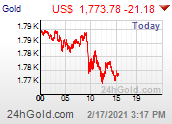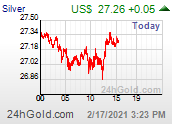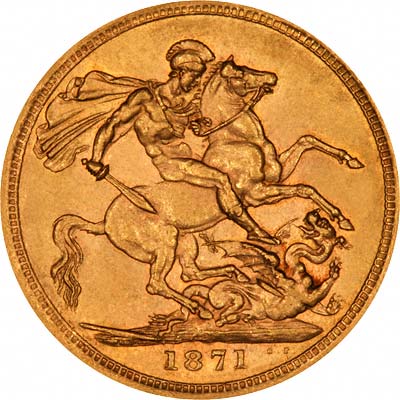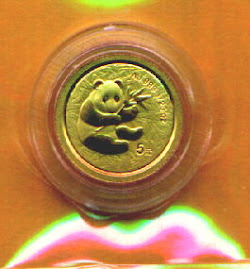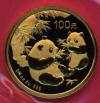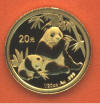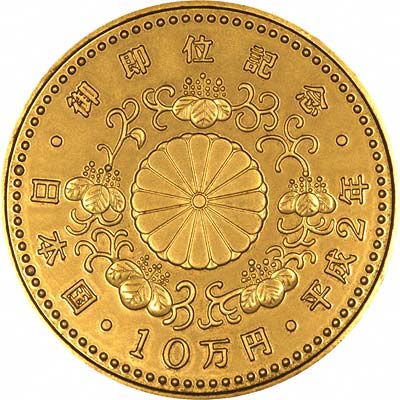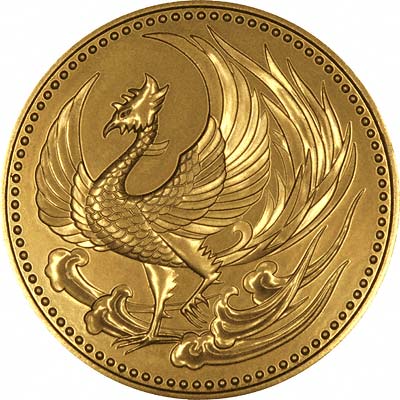By SARA LEPRO
AP Business Writer
Published: Tuesday, Jan. 20, 2009
NEW YORK -- Gold prices advanced Tuesday as investors sought safety amid fears of a deepening global banking crisis. Other commodities fell amid expectations that demand will continue to weaken.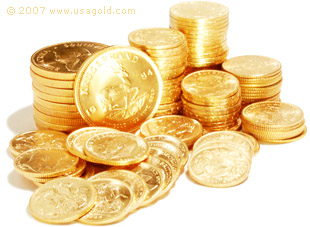
Signs that banks are still suffering big losses from soured loans, and warnings that those losses will continue for some time have investors worried that the government's efforts to prop up the financial system won't be enough. That rattled Wall Street Tuesday, causing investors to flee stocks and move their money to more traditionally safe investments like gold.
The Dow Jones industrials plunged 332 points, or 4 percent, to finish at 7,949. Broader stock indexes lost more than 5 percent.
Gold, which typically moves inversely with the dollar, also rose despite signs of strength in the U.S. currency. Gold prices tend to benefit when the dollar is weak, as the contract is often used as a hedge against inflation.
On Tuesday, the dollar gained ground against the euro and the British pound after the British government announced a second rescue plan for the country's banks in just over three months. Separately, the British government increased its stake in the Royal Bank of Scotland to nearly 70 percent, after the bank forecast for a loss of $41.3 billion in 2008.
The report dovetailed with discouraging results at U.S. banks. Regional bank Regions Financial Corp. reported a fourth-quarter loss of $6.24 billion due to a hefty one-time charge to reflect declining value in its banking reporting unit. And State Street Corp. reported a 71 percent drop in fourth-quarter earnings and warned of a difficult year ahead.
The news followed reports of multibillion losses announced Friday by Citigroup Inc. and Bank of America Corp.
Plagued by concerns about a drop in demand for raw materials amid a worsening recession, commodities prices have shown little strength so far this year - extending a trend that began in the middle of 2008 as the economy took a turn for the worst. But investors often look to gold in times of economic uncertainty, so prices have been cushioned from some of the fears about falling prices that are hurting other commodities.
"Gold will not necessarily move in line with other commodities at all," said Natalie Dempster, head of investment at World Gold Council.
"Gold has different fundamentals," Carlos Sanchez, analyst with CPM Group in New York, agreed. "It's not as supply-demand based, it's more investor based. I think you saw that today with the stock market lower and some safe-haven buying."
Gold for February delivery gained $15.30 to settle at $855.20 an ounce on the New York Mercantile Exchange.
Other precious metals prices fell. March silver shed 4 cents to $11.1750 an ounce, while March copper futures fell 2.3 cents to $1.5045 a pound.
The yield on the benchmark 10-year Treasury note, which moves opposite its price, rose to 2.35 percent from 2.34 percent late Friday.
Energy prices fell on the Nymex, revealing little optimism that energy demand will improve.
Light, sweet crude for March delivery fell $1.53 to settle at $40.68.
A limited number of traders took advantage of the February contract which expires Tuesday. That contract rose $2.23 to settle at $38.74 per barrel. Trading in the final day of the contract was very light.
In other Nymex trading, gasoline futures fell 2.4 cents to settle at $1.1431 a gallon, while heating oil dropped 9.76 cents to settle at $1.3758 a gallon.
Grain prices slumped on the Chicago Board of Trade.
March wheat futures tumbled 28.25 cents to $5.50 a bushel, while corn for March delivery fell 7.5 cents to $3.835 a bushel. March soybeans fell 28 cents to $9.92 a bushel.
Read more...
Alasan Fundamental Untuk Memilih Dinar…
1. Dinar emas adalah uang yang digunakan oleh Rasulullah SAW tidak hanya untuk jual beli, tetapi juga untuk penerapan syariah itu sendiri.
a. Nisab zakat yang diukur dengan 20 Dinar atau 200 Dirham.
b. Batasan Hukum potong tangan bagi pencuri batasannya adalah nisab pencuri ¼ Dinar.
c. Diyat atau uang darah [dibebaskan dari hukum qisas (dibunuh)] yang besarannya 1000 Dinar.
Lantas bagaimana kita bisa tahu seseorang menjadi wajib zakat atau malah sebaliknya berhak menerima zakat kalau ukurannya yang berupa Dinar atau Dirham saja kita tidak mengenalnya ?.
2. Fakta di dunia modern ini bahwa uang kertas tidak akan bertahan terlalu lama. Semua uang kertas yang ada di dunia modern ini, tidak ada satupun yang telah membuktikan dirinya bisa survive dalam seratus tahun saja. Bisa jadi nama uangnya masih ada, tetapi jelas daya belinya sangat jauh berbeda dalam rentang waktu tersebut.
Padahal disisi lain ada uang yang daya belinya terbukti tetap lebih dari 1400 tahun yaitu Dinar. Di jaman Rasulullah SAW 1 Dinar cukup untuk membeli kambing, saat inipun 1 Dinar bisa membeli kambing yang baik di Jakarta.
Grafik Harga Emas Harian - Mingguan - Bulanan -Tahunan
Investasi Emas : Koin Dinar, Emas Lantakan Atau Emas Perhiasan ?
 Default value (nilai) uang kertas, saham,
Default value (nilai) uang kertas, saham, Nah sekarang sama-sama investasi emas, mana yang kita pilih ? Koin Emas, Emas Lantakan atau Perhiasan ?
BACA SELENGKAPNYA...........
Kamis, 22 Januari 2009
Gold prices advance as investors seek safety
Selasa, 20 Januari 2009
Hanya Ada Satu Penantang US Dollar :
Written by Muhaimin Iqbal
Tuesday, 20 January 2009 08:25
“Sebagai akibat dari resesi skala gobal, tidak ada negara yang menginginkan mata uangnya terapresiasi. Alternative bagi US Dollar tahun 2009 bukanlah mata uang negara lain, tetapi ‘mata uang kuno’ yaitu emas. Logam Mulia dapat muncul sebagai hedge atas kecurigaan investor terhadap perilaku bank sentral dan ketakutan akan inflasi…”. David Hales dalam tulisannya tanggal 5 Januari lalu di Financial Times.
Ini bukan kali pertama saya menemukan penulis barat yang objektif tentang mata uang. Pemikir-pemikir di Gold Anti Trust Action Committee (GATA) sudah lama mengungkapkan pandangannya yang senada, Ter-wacanakan-nya Bretton Wood II oleh para pemimpin dunia G-20 juga tidak terlepas dari pengakuan bahwa sebenarnya emas-lah uang yang sejati itu.
Berbeda dengan kita yang meyakini uang yang sejati (timbangan yang adil) hanyalah emas dan perak berdasarkan keyakinan agama kita, David Hales berkesimpulan bahwa pengganti US Dollars hanyalah emas berdasarkan kondisi financial global terkini, sebagaima antara lain terungkap dalam beberapa realita berikut:
· Seluruh pemain ekonomi dunia tergelincir dalam resesi. Real GDP di Amerika dan di Eropa akan mencapai minus 1.5%, dan Jepang akan lebih buruk lagi dan bisa mencapai minus 2.5%.
· Response dari negara-negara Eropa (yang sebenarnya memiliki calon kuat mata uang pengganti US$ yaitu Euro), jauh lebih lamban dari respon Amerika dalam bentuk berbagai stimulus ekonomi. Jadi mata uangnya juga tidak bisa diharapkan.
· China yang terpukul oleh krisis ini, diperkirakan tidak akan intervensi pasar untuk menaikkan nilai tukar mata uangnya. Pertama karena cadangan devisa mereka mulai menurun, kedua menaikkan nilai tukar mata uang akan menurunkan daya saing ekspornya yang saat inipun sudah terganggu.
· Mata uang Jepang yang saat masih kuat kedepannya akan cenderung ditekan oleh pemerintahnya sendiri dengan alasan yang sama yaitu karena penurunan ekspor dan penurunan kapasitas produksi.
· Lalu lintas perdagangan dunia akan turun karena negara-negara pengimpor besar mengalami resesi. Tidak hanya Eropa, Amerika dan Jepang, tetapi juga yang tidak kalah buruk adalah Korea Selatan, Taiwan dan Cina.
Amerika tetap boleh bangga memiliki mata uang yang terkuat diantara mata uang-mata uang lain yang lemah. Namun ini hanya terjadi selama penantangnya yang sesungguhnya – yaitu emas/Dinar – belum muncul. Tidak heran mengapa pemerintah mereka selalu memusuhi emas, sampai-sampai warga mereka sendiri yang menyadari bahwa mereka terdhalimi oleh pemerintahnya – mendirikan berbagai organisasi untuk melawannya seperti GATA, FAME (Foundation of Advance Monetary Education) dlsb.
Bagi kita umat Islam; kepada kita sudah dikabarkan tentang kehancuran mereka ini – namun apakah kita yang akan menggantikannya ? tergantung kemauan kita untuk mulai bekerja untuk ini.
“Dia-lah yang mengeluarkan orang-orang kafir di antara ahli Kitab dari kampung-kampung mereka pada saat pengusiran kali yang pertama. Kamu tiada menyangka, bahwa mereka akan keluar dan mereka pun yakin, bahwa benteng-benteng mereka akan dapat mempertahankan mereka dari (siksaan) Allah; maka Allah mendatangkan kepada mereka (hukuman) dari arah yang tidak mereka sangka-sangka. Dan Allah mencampakkan ketakutan ke dalam hati mereka; mereka memusnahkan rumah-rumah mereka dengan tangan mereka sendiri dan tangan orang-orang yang beriman. Maka ambillah (kejadian itu) untuk menjadi pelajaran, hai orang-orang yang mempunyai pandangan.” (QS 59 :2)
Jadi Allah telah menghancurkan (ekonomi) mereka dengan tangan-tangan mereka sendiri, yang diperlukan sekarang adalah munculnya tangan-tangan kaum mukminin untuk menggantikannya. Kalau tangan-tangan kaum mukminin tidak juga segera muncul, maka yang akan muncul bisa jadi kedhaliman lain dalam bentuknya yang baru. Wallahu A’lam.
Last Updated on Tuesday, 20 January 2009 08:35
Copyright © 2009 Gerai Dinar. All Rights Reserved.
Joomla! is Free Software released under the GNU/GPL License.
Read more...
Senin, 05 Januari 2009
Peter Schiff: Gold Will Rise, Dollar Will Collapse....
Written by Administrator
Wednesday, 19 November 2008 14:48
The opinions expressed in this presentation are those of the interviewee and interviewer and may differ from those of other persons. These views are not intended to be a forecast of future results, or investment advice. The information is not intended to represent any past or future investment recommendation, and any market conditions described may not continue.Mike Norman, HardAssetsInestor.com (Norman): Hello everybody, and welcome back for another installment of HardAssetsInvestor.com’s interview series. I’m Mike Norman, your host. Well, he’s back. Mr. Doom and Gloom is here … Peter Schiff, president of Euro Pacific Capital and author of the new book just out, “Bull Moves in Bear Markets.”
Peter Schiff, president of Euro Pacific Capital (Schiff): “The Little Book ...”
Norman: “The Little Book …”; it’s in The Little Book Series. Well look … the last time you were here, things were kind of going your way, but it looks like things have turned upside down.

All kidding aside, I know your big thing over the last seven or eight years has been gold. We’re very supportive of gold on this show; we think that probably people should have some gold as part of their overall portfolio mix. But let’s just look at what happened.
Several weeks ago, the U.S. stock market had its worst week in history … even going back to the 1930s … worst week in history. I saw a breakdown of various assets – all assets really – stocks, bonds, gold, commodities, oil. Gold was at the bottom of the list. The top-performing asset, and something that you hate, was the U.S dollar.
So how do you explain that? If we are going through the worst economic and financial crisis in history – precisely what gold is supposed to protect against – why would it perform so bad?
Schiff: Well, I think it will perform very well; you got to give it a little bit more time.
Norman: More time or more decimation?
Schiff: No, what’s happening right now, Mike, is just de-leveraging, and so gold is going down for the same reason a lot of stocks are going down, a lot of commodities are going down. There’s a lot of leverage in this system, there’s a lot of margin calls, a lot of liquidation; a lot of people are having to sell whatever they own to pay off their debts.
Norman: But look at where the money is going … the money is going into U.S. sovereigns, Treasuries … it’s going into the U.S. dollar.
Schiff: For now.
Norman: Why for now?
Schiff: Right now there’s some perception of safety there, but it’s the opposite of the leveraging. If you’re selling your assets, you’re accumulating dollars; but ultimately right now, it’s like there’s been this gigantic nuclear explosion in the United States, and everybody is running toward the blast. Pretty soon they’re going to figure out they’re going in the wrong direction.
Norman: You always talk about gold as a currency, and we have seen currencies appreciate – the yen, for example, the dollar tremendously, for example, but gold has not held up.
Schiff: Well, if you actually look at gold versus other currencies, in the last couple of weeks gold has made new record highs in terms of the South African rand, the Canadian and Australian dollars … so gold was not doing as poorly as many of the currencies, and I think this is all short term.
I think you’re going to see a lot of money moving into gold, and if you look at how much gold has gone down from the peak, the peak was about a thousand … it’s off about 25%. Stocks are off 40%. Gold is still up during this year against the Dow.
Norman: Let’s see the performance from this point forward; we’ll look back at this again and we’ll revisit this issue.
Let’s talk about something else, something that you have also … and I just mentioned it … the U.S. dollar. You were very, very negative. In the last month, we have seen unprecedented actions by the U.S. Fed in terms of expansion of the monetary basis; in other words, printing money … what you call printing money … and despite that, the dollar has remained incredibly strong.
How do you explain that according to your logic?
Schiff: Everything the government is doing is inherently negative for the dollar, and all of this…
Norman: It’s not playing out that way.
Schiff: It will; you’ve got to give it time.
I remember when I was on television talking about the subprime and people were telling me it’s no big deal, and I said, just wait a while; give it time.
Look, everything that we’re doing – all the bailouts, all the stimulus packages – this is all being financed by inflation. It’s inherently terrible for the dollar.
Norman: But you just said yourself that everything is deflating.
Schiff: But right now, Mike, you’re getting this de-leveraging, and this is benefitting the dollar, so despite the horrific fundamentals for the dollar, it’s going up anyway.
But ultimately, when this phony rally runs out of steam, the dollar is going to collapse, and that’s when we’re going to have a much greater crisis because now you’re going to have a collapsing dollar, which is going to push long-term interest rates up, commodity prices up.
Norman: I still don’t understand why the dollar is going to collapse. So you’re saying that the Fed is just going to allow … or leave this enormous amount of liquidity in there, that at some point down the road, if we recover, they’re not going Scto take it out?
Schiff: Look, they have no control over it. The Fed is trying to artificially reflate our phony economy, right?
We had this economy that was based on Americans borrowing money and then spending it on products. We have this huge debt finance bubble which is collapsing, and it’s being supported by foreigners.
But when this artificial demand for Treasuries goes away, the Fed is going to try to print a lot of money and the dollar is going to get killed.
Norman: All right; I’m going to ask you to hold on. Folks, check back because we’re going to do the second part of my interview with Peter Schiff, so check back to this site. This is Mike Norman; bye for now.
Read more...
Investasi Emas, Why Not?
 Emas dari dulu memang menjadi fenomena yang menarik hati. Memang benar apa yang dilakukan para orang tua jaman dulu yang gemar membeli emas atau tanah dari pada barang lainnya. Karena mereka tahu bahwa harga emas bakal naek terus dari tahun ke tahun. Investasi emas untuk jangka panjang (long term) memang sangat menjanjikan disamping simple juga tidak terlalu membutuhkan keahlian khusus untuk menjalankannya. Sama halnya dengan investasi tanah. Kendalanya mungkin pada keamanan penyimpanan emas itu sendiri, apakah di simpan di rumah atau di bank (Safe Deposit Box Bank). Perjalanan harga emas dari tahun ke tahun sangat fantastis, tahun 1998 harga emas per gramnya mencapai Rp 25,000,-, tahun 2004 sudah mencapai Rp. 90,000,-, sedangkan sekarang harga per gramnya per tanggal 29 Mei 2008 sudah mencapai Rp. 279,000,-. Memang harga emas belakangan ini sempat naik turun akibat fluktuasi harga minyak dunia. Ya, setidaknya kita perlu jeli untuk memanfaatkan peluang berinvestasi emas mengingat kondisi tersebut.
Emas dari dulu memang menjadi fenomena yang menarik hati. Memang benar apa yang dilakukan para orang tua jaman dulu yang gemar membeli emas atau tanah dari pada barang lainnya. Karena mereka tahu bahwa harga emas bakal naek terus dari tahun ke tahun. Investasi emas untuk jangka panjang (long term) memang sangat menjanjikan disamping simple juga tidak terlalu membutuhkan keahlian khusus untuk menjalankannya. Sama halnya dengan investasi tanah. Kendalanya mungkin pada keamanan penyimpanan emas itu sendiri, apakah di simpan di rumah atau di bank (Safe Deposit Box Bank). Perjalanan harga emas dari tahun ke tahun sangat fantastis, tahun 1998 harga emas per gramnya mencapai Rp 25,000,-, tahun 2004 sudah mencapai Rp. 90,000,-, sedangkan sekarang harga per gramnya per tanggal 29 Mei 2008 sudah mencapai Rp. 279,000,-. Memang harga emas belakangan ini sempat naik turun akibat fluktuasi harga minyak dunia. Ya, setidaknya kita perlu jeli untuk memanfaatkan peluang berinvestasi emas mengingat kondisi tersebut.
Kenapa Emas?
TEORI INVESTASI
Jangan Taruh semua Telor dalam satu keranjang. Pastikan investasi anda berada dalam beberapa instrumen invesatsi anda selain tanah, saham, obligasi, dan emas tentunya.
SEJARAH BERKATA
Sejarah membuktikan emas tidak memiliki efek inflasi (ZERO INFLATION EFFECT) dan cendrung stabil dengan nilai yang riil.
TEORI KELANGKAAN (SCARCITY)
Di beberapa negara terjadi penurunan produksi emas, sehingga menimbulkan kelangkaan (scarcity) emas di masyarakat sedangkan permintaan terhadap emas meningkat. Hal ini bisa memicu kenaikan harga emas.
(Ditulis oleh : Gede Suarnaya, dari berbagai sumber)





 Thursday, 11 February 2010 08:35
Thursday, 11 February 2010 08:35 
